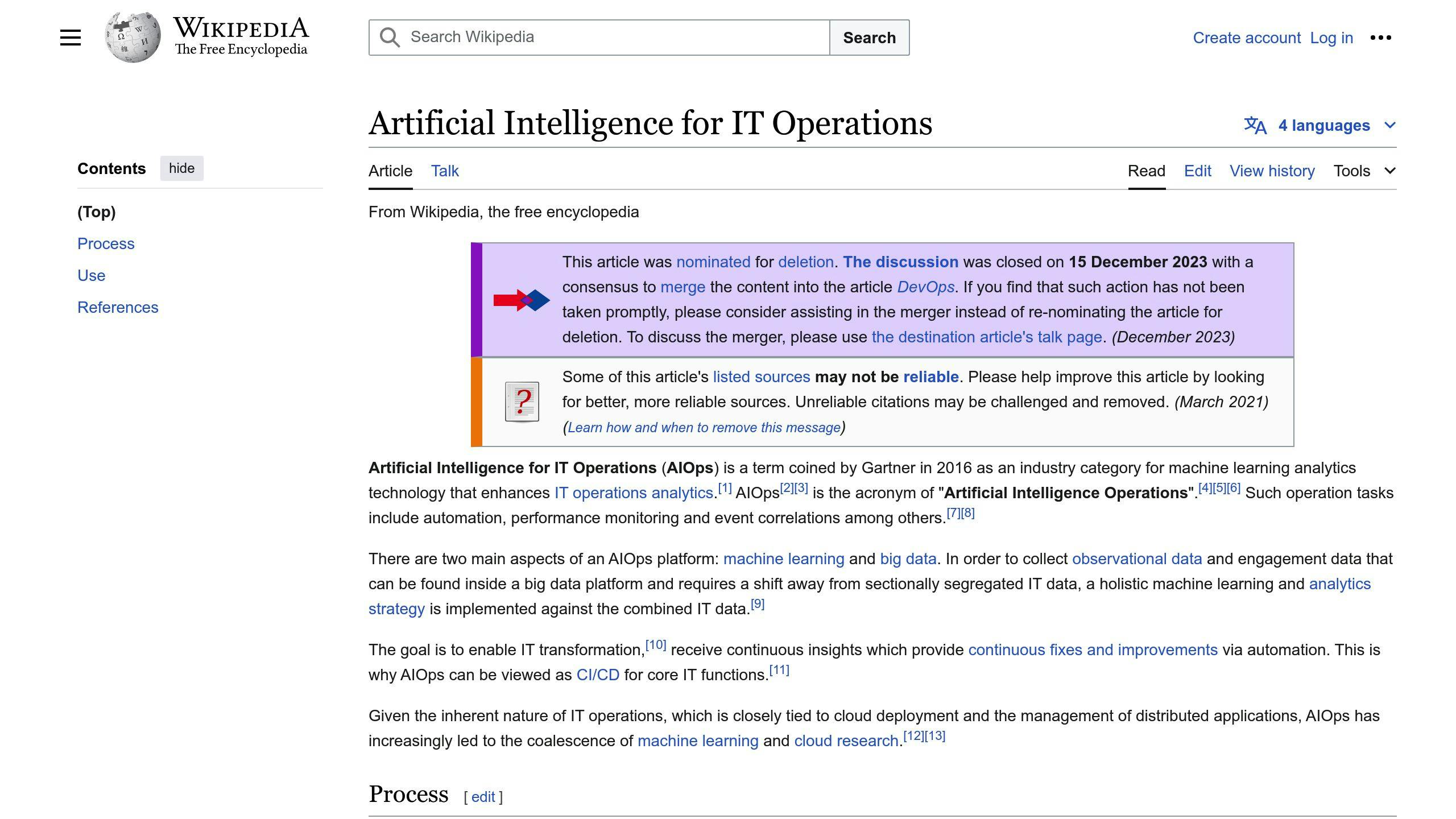AIOps (Artificial Intelligence for IT Operations) is a set of tools and platforms that leverage machine learning and data analytics to automate IT operations tasks. By adopting AIOps, organizations can:
- Detect issues proactively before they impact performance or cause downtime
- Automate incident response and remediation tasks
- Improve overall IT efficiency and productivity
To unlock the full potential of AIOps and stay ahead in an ever-evolving IT landscape, here are 10 key strategies:
- Choose an AIOps Platform That Integrates with Your Existing Tools
- Define Clear AIOps Goals and Operations Upfront
- Identify Relevant Data and Data Sources
- Maintain High Data Quality Standards
- Start with a Small Test Project
- Shift from Reactive to Proactive IT Operations
- Automate Routine Tasks
- Facilitate Collaborative Operations
- Focus on Data Security and Privacy
- Drive Continuous Insights and Improvement
Related video from YouTube
Quick Comparison of AIOps Strategies

| Strategy | Integrates with Existing Tools | Defines Goals | Focuses on Relevant Data | Ensures Data Quality | Enables Proactive Operations | Automates Tasks | Promotes Collaboration | Prioritizes Security & Privacy | Supports Continuous Improvement |
|---|---|---|---|---|---|---|---|---|---|
| Domain-Centric | ✅ | ✅ | ✅ | ✅ | ❌ | ✅ | ✅ | ✅ | ✅ |
| Domain-Agnostic | ✅ | ✅ | ✅ | ✅ | ✅ | ✅ | ✅ | ✅ | ✅ |
| Hybrid Approach | ✅ | ✅ | ✅ | ✅ | ✅ | ✅ | ✅ | ✅ | ✅ |
Successful AIOps adoption requires proper setup, realistic expectations, and stakeholder involvement. By implementing these strategies, organizations can enhance productivity, streamline workflows, and drive continuous improvement in their IT operations.
1. Choose an AIOps Platform That Works With Your Current Tools
Connecting With Existing Systems
For a smooth transition, pick an AIOps platform that easily connects with your current monitoring, ticketing, and automation tools. This minimizes disruptions to your workflows and maximizes the value of your previous investments.
Handling Diverse Data
An effective AIOps solution should handle various data formats and types from your IT environment, including logs, metrics, events, and traces. This comprehensive data ingestion enables the platform to provide insights across your entire technology stack.
Data Quality Matters
Look for an AIOps platform with robust data cleansing and normalization capabilities. This ensures the data fed into the system is consistent, reliable, and error-free, enabling accurate insights and recommendations.
Proactive Issue Detection
One key advantage of AIOps is its ability to detect anomalies and predict potential issues before they occur. Choose a platform that uses machine learning algorithms for proactive operations, enabling you to take preventive measures and ensure business continuity.
Automation Capabilities
AIOps platforms should offer automation features to streamline IT operations tasks. Look for automation of incident response, remediation, and workflow orchestration to reduce manual effort and improve consistency.
Collaboration Tools
Effective collaboration is crucial for efficient IT operations. Choose an AIOps platform that promotes collaboration through shared dashboards, real-time alerts, and communication channels. This facilitates seamless communication and coordination among teams.
Security and Compliance
As AIOps platforms handle sensitive data, prioritize security and privacy. Look for solutions with robust access controls, data encryption, and compliance with relevant industry standards and regulations to protect your organization's data and systems.
Continuous Improvement
AIOps is an iterative process that requires ongoing learning and model refinement. Choose a platform that supports continuous improvement, allowing the system to evolve and adapt to changes in your IT environment.
| Key Feature | Description |
|---|---|
| Integration | Seamless connection with existing IT operations tools |
| Data Handling | Ability to ingest and analyze diverse data formats and types |
| Data Quality | Robust data cleansing and normalization capabilities |
| Proactive Operations | Machine learning for anomaly detection and issue prediction |
| Automation | Automation of incident response, remediation, and workflow orchestration |
| Collaboration | Shared dashboards, real-time alerts, and communication channels |
| Security and Compliance | Robust access controls, data encryption, and regulatory compliance |
| Continuous Improvement | Support for ongoing learning and model refinement |
2. Define Clear AIOps Goals and Operations Upfront
Set Specific Goals
Clearly define the areas of IT operations you want to improve, such as:
- Incident management
- Performance monitoring
- Capacity planning
Set measurable targets like:
- Reducing mean time to resolution (MTTR)
- Improving service availability
- Optimizing resource utilization
Well-defined goals will guide your AIOps strategy and help measure its effectiveness.
Identify Relevant Data Sources
Determine the data sources and types most relevant to your goals, such as:
- Logs
- Metrics
- Events
- Traces
Ensure the AIOps platform can ingest and analyze these diverse data formats.
Ensure Data Quality
Look for solutions with robust data cleansing and normalization capabilities to ensure:
- Consistent data
- Reliable data
- Error-free data
This will prevent false positives, improve anomaly detection, and enable accurate root cause analysis.
Enable Proactive Operations
Choose an AIOps platform that uses machine learning algorithms for:
- Detecting anomalies
- Predicting potential issues
This will allow you to take preventive measures and ensure business continuity.
Automate Processes
Look for features that automate:
- Incident response
- Remediation
- Workflow orchestration
Automation can improve consistency, reduce human error, and free up resources.
Facilitate Collaboration
Choose a platform that promotes collaboration through:
- Shared dashboards
- Real-time alerts
- Communication channels
This will enable seamless communication and coordination among teams.
Prioritize Security and Privacy
Look for solutions with:
- Access controls
- Data encryption
- Compliance with industry standards and regulations
This will protect your organization's data and systems.
Support Continuous Improvement
Choose a platform that supports ongoing learning and model refinement, allowing the system to adapt to changes in your IT environment.
3. Identify Relevant Data and Data Sources
Determine Relevant Data
To ensure the success of your AIOps strategy, you need to identify the data sources and types that are most relevant to your goals. This could include:
- Logs
- Metrics
- Events
- Traces
Make sure the AIOps platform you choose can ingest and analyze these diverse data formats.
Integrate with Existing Tools
Your AIOps platform should be able to integrate with your current tool stack, such as:
- Monitoring tools
- Incident management tools
- Automation tools
This integration allows the platform to collect data from various sources, providing a comprehensive view of your IT operations.
Ensure Data Quality
Data quality is critical for accurate AIOps insights. Look for solutions with robust data cleansing and normalization capabilities to ensure:
- Consistent data
- Reliable data
- Error-free data
This will prevent false positives, improve anomaly detection, and enable accurate root cause analysis.
| Data Quality Aspect | Description |
|---|---|
| Consistency | Data should be uniform and follow the same format across sources. |
| Reliability | Data should be accurate and free from errors or inconsistencies. |
| Error-free | Data should be thoroughly cleaned and normalized to eliminate any errors or anomalies. |
4. Maintain High Data Quality Standards
Clean and Consistent Data
High-quality data is crucial for AIOps to work well. Poor data quality can lead to incorrect insights, false alerts, and ineffective root cause analysis. To maintain high data standards, ensure your AIOps platform can handle diverse data formats like logs, metrics, events, and traces.
Data Cleansing and Normalization
Data cleansing and normalization are vital steps to ensure data quality. Look for AIOps solutions with robust capabilities to:
- Eliminate errors
- Remove inconsistencies
- Deduplicate data
This enables accurate anomaly detection, reliable root cause analysis, and effective incident response.
Relevant Data and Integration
Ensure the AIOps platform can integrate with your existing tools, including:
| Tool Type | Examples |
|---|---|
| Monitoring | Nagios, Zabbix, Prometheus |
| Incident Management | ServiceNow, Jira Service Desk |
| Automation | Ansible, Puppet, Chef |
This integration allows the platform to collect relevant data from various sources, providing a comprehensive view of your IT operations.
5. Start with a Small Test Project
Try a Small Case First
Before fully implementing AIOps, start with a small test project. This lets you:
- Learn quickly
- Identify potential issues early
- Refine your strategy
A small test case allows you to fine-tune your tools and develop a clear plan for scaling up.
Set Clear Goals
Before starting the test project, define clear goals and objectives. Identify specific areas of IT operations that can benefit from AIOps, such as:
- Incident management
- Performance optimization
- Capacity planning
Clear objectives help measure the test project's success and make informed decisions for future implementations.
Choose the Right Tools
Select AIOps tools and technologies that align with your goals. Consider:
- Open-source, low-cost ML models for testing
- More robust platforms (with similar costs)
Ensure the chosen tools can integrate with your existing infrastructure and provide the necessary features.
Involve Key Stakeholders
Involve relevant stakeholders and teams, including:
- IT operations
- DevOps
- Data analytics
Collaboration helps identify skill gaps and ensures a comprehensive strategy that addresses various teams' needs.
Monitor and Adjust
Monitor the test project's progress and refine your approach as needed. Collect feedback from stakeholders and use it to improve the AIOps strategy. This iterative process helps develop a robust implementation tailored to your organization's needs.
| Step | Description |
|---|---|
| 1. Start Small | Begin with a small test case to learn and identify challenges. |
| 2. Set Goals | Define clear objectives for the test project. |
| 3. Choose Tools | Select tools that align with your goals and integrate with existing infrastructure. |
| 4. Involve Stakeholders | Engage relevant teams to identify skill gaps and address their needs. |
| 5. Monitor and Adjust | Monitor progress, collect feedback, and refine the strategy as needed. |
sbb-itb-9890dba
6. Shift from Reactive to Proactive IT Operations
Proactive Issue Detection
AIOps enables IT teams to identify potential issues before they impact performance or cause downtime. By using advanced analytics and machine learning, AIOps can detect anomalies and predict problems proactively. This proactive approach minimizes system disruptions and optimizes resource usage.
Automated Incident Management
AIOps automates routine tasks, streamlining IT operations and reducing manual effort. This allows IT staff to focus on strategic initiatives and respond quickly to changing business needs. Automated procedures, such as faster root cause analysis, enable teams to detect and remediate incidents in real-time, minimizing disruptions to business operations.
Collaborative Incident Resolution
AIOps provides a single view for IT teams to work together on issue detection, diagnosis, and resolution before users or performance are affected. This collaboration helps preserve event data that could be essential for identifying similar future issues.
| Benefit | Description |
|---|---|
| Proactive Issue Detection | Identify potential problems before they cause downtime or performance issues. |
| Automated Incident Management | Automate routine tasks, freeing up IT staff for strategic work and enabling real-time incident response. |
| Collaborative Incident Resolution | Facilitate teamwork on issue detection, diagnosis, and resolution, preserving event data for future reference. |
7. Automate Routine Tasks
Automation in AIOps
AIOps automation plays a key role in scaling and preparing IT operations for the future. By automating routine tasks, IT teams can focus on strategic work, reduce manual effort, and boost efficiency. AIOps automation enables organizations to:
- Reduce alert noise: Automate alert filtering, suppression, and prioritization to minimize distractions and ensure critical issues receive prompt attention.
- Streamline incident response: Automate incident detection, diagnosis, and resolution to reduce mean time to detect (MTTD) and mean time to resolve (MTTR).
- Optimize resource usage: Automate resource allocation and scaling to ensure resources are utilized efficiently.
Benefits of Automation
The benefits of automation in AIOps are numerous:
- Increased efficiency: Automation reduces manual effort, freeing up IT staff for strategic initiatives and improving productivity.
- Improved accuracy: Automation minimizes human error, ensuring tasks are performed consistently and accurately.
- Enhanced scalability: Automation enables organizations to scale IT operations more efficiently, reducing resource constraints and performance bottlenecks.
| Benefit | Description |
|---|---|
| Increased Efficiency | Reduces manual effort, allowing IT staff to focus on strategic work and improving productivity. |
| Improved Accuracy | Minimizes human error, ensuring tasks are performed consistently and accurately. |
| Enhanced Scalability | Enables organizations to scale IT operations more efficiently, reducing resource constraints and performance bottlenecks. |
8. Facilitate Collaborative Operations
Collaboration is key for AIOps, enabling teams to work together smoothly to identify and resolve issues quickly. Facilitating collaborative operations involves integrating AIOps with existing tools, setting shared goals, and fostering a collaborative culture.
Integrate with Existing Tools
AIOps platforms should integrate with tools and systems teams already use, such as:
- IT service management (ITSM) tools
- Incident management tools
- Collaboration platforms
This integration allows teams to access AIOps capabilities from within their familiar workflows, promoting adoption and collaboration.
Define Common Goals
Setting clear, shared goals and key performance indicators (KPIs) aligned with business objectives is essential. This ensures teams are working towards the same vision.
Enable Collaboration
AIOps provides a single view for teams to access and analyze data, identify issues, and collaborate on resolutions in real-time. This reduces mean time to detect (MTTD) and mean time to resolve (MTTR).
By facilitating collaborative operations, AIOps helps organizations:
| Benefit | Description |
|---|---|
| Improve Incident Response | Teams can respond to incidents more quickly, reducing downtime and improving user experience. |
| Enhance Communication | Collaboration and communication across teams are improved, ensuring all stakeholders are informed and aligned. |
| Increase Efficiency | Routine tasks are automated, allowing teams to focus on strategic initiatives, boosting productivity. |
| Reduce Errors | Human error is minimized, ensuring tasks are performed consistently and accurately. |
9. Focus on Data Security and Privacy
Data Protection
AIOps platforms collect and process large amounts of data from various sources like logs, metrics, events, and traces. This data often contains sensitive information about systems, applications, and users. To prevent data breaches and unauthorized access, organizations must implement robust protection measures:
- Encryption: Encrypt data at rest and in transit to secure it from unauthorized access.
- Access Controls: Implement strict access controls to ensure only authorized personnel can access sensitive data.
- Anonymization: Anonymize or remove personally identifiable information (PII) from data to protect user privacy.
Threat Detection and Response
AIOps systems can detect and respond to security threats in real-time by analyzing patterns and anomalies in IT data. However, adversaries may attempt to exploit vulnerabilities in these systems. To mitigate this risk:
- Continuous Monitoring: Continuously monitor AIOps platforms for suspicious activities.
- Threat Detection: Implement proactive threat detection mechanisms to identify potential attacks.
Regulatory Compliance
Organizations must comply with data protection regulations like GDPR, CCPA, and HIPAA to avoid hefty fines and legal issues. To ensure compliance:
| Compliance Measure | Description |
|---|---|
| Data Governance Policies | Implement robust data governance policies to ensure proper data handling. |
| Regular Audits | Conduct regular audits to verify compliance with regulations. |
| Transparency | Ensure transparency in data processing activities. |
10. Drive Continuous Insights and Improvement
Continuously improving AIOps is key to staying ahead. This involves monitoring the platform, updating it with the latest AI and machine learning advancements, and refining strategies based on insights.
Integrate with Existing Tools
Integrate AIOps with your current tools and systems. This allows seamless data exchange and a comprehensive view of IT operations.
Define Goals
Set clear goals and key performance indicators (KPIs) to measure the success of AIOps initiatives.
Focus on Relevant Data
Select the right data sources, filter out noise, and focus on data that provides actionable insights.
Continuously Improve
Regularly review and refine AIOps strategies. Identify areas for improvement and implement changes to optimize IT operations.
| Step | Description |
|---|---|
| Integrate | Connect AIOps with existing tools for seamless data exchange. |
| Define Goals | Set clear goals and KPIs to measure success. |
| Focus on Data | Select relevant data sources and filter out noise. |
| Improve Continuously | Regularly review, refine, and optimize AIOps strategies. |
Comparing AIOps Strategies
When choosing an AIOps strategy, it's crucial to understand the differences between the available options. Here's a comparison table to help you make an informed decision:
| Strategy | Integrates with Existing Tools | Defines Goals | Focuses on Relevant Data | Ensures Data Quality | Enables Proactive Operations | Automates Tasks | Promotes Collaboration | Prioritizes Security & Privacy | Supports Continuous Improvement |
|---|---|---|---|---|---|---|---|---|---|
| Domain-Centric | ✅ | ✅ | ✅ | ✅ | ❌ | ✅ | ✅ | ✅ | ✅ |
| Domain-Agnostic | ✅ | ✅ | ✅ | ✅ | ✅ | ✅ | ✅ | ✅ | ✅ |
| Hybrid Approach | ✅ | ✅ | ✅ | ✅ | ✅ | ✅ | ✅ | ✅ | ✅ |
Legend:
✅: Feature Supported ❌: Feature Not Supported
As shown in the table:
- Domain-Centric: Focuses on a specific domain but lacks proactive operations capabilities.
- Domain-Agnostic: Provides comprehensive IT operations management with proactive features.
- Hybrid Approach: Combines the benefits of both domain-centric and domain-agnostic strategies.
When selecting a strategy, consider your organization's specific needs and goals. Each approach has its strengths and weaknesses, so choose the one that best aligns with your requirements.
Key Takeaways
AIOps: A Continuous Journey
AIOps is not a one-time implementation but an ongoing process that requires continuous development and learning. Organizations must be prepared to refine and adapt their AIOps strategies as their IT environments evolve.
Measure Success with Quantifiable Metrics
To gauge the effectiveness of AIOps initiatives, focus on tangible outcomes with quantitative proof points. Define clear key performance indicators (KPIs) that align with your goals, such as reducing mean time to resolution (MTTR) or improving service availability.
Boost Productivity and Efficiency
AIOps is about enhancing productivity, streamlining workflows, and improving staff efficiency. Leverage AIOps platforms to automate routine tasks, freeing up IT teams to focus on strategic initiatives.
Leverage AIOps for Specific Use Cases
Utilize AIOps platforms for scenarios like adaptive anomaly detection or system-centric anomaly detection. Identify the specific use cases that align with your organization's needs and goals.
Proper Setup and Expectations
Successful AIOps adoption requires proper setup and realistic expectations. Remember that setting up AIOps can be a complex, multi-faceted process. Involve stakeholders, define clear objectives, and allocate sufficient resources for a smooth implementation.
Presentation of Key Points
| Key Point | Description |
|---|---|
| Continuous Journey | AIOps requires ongoing development and learning to adapt to evolving IT environments. |
| Quantifiable Metrics | Define clear KPIs to measure the success of AIOps initiatives. |
| Productivity Boost | AIOps enhances productivity, streamlines workflows, and improves staff efficiency. |
| Specific Use Cases | Leverage AIOps platforms for scenarios like adaptive anomaly detection or system-centric anomaly detection. |
| Proper Setup | Successful AIOps adoption requires proper setup, realistic expectations, and stakeholder involvement. |



